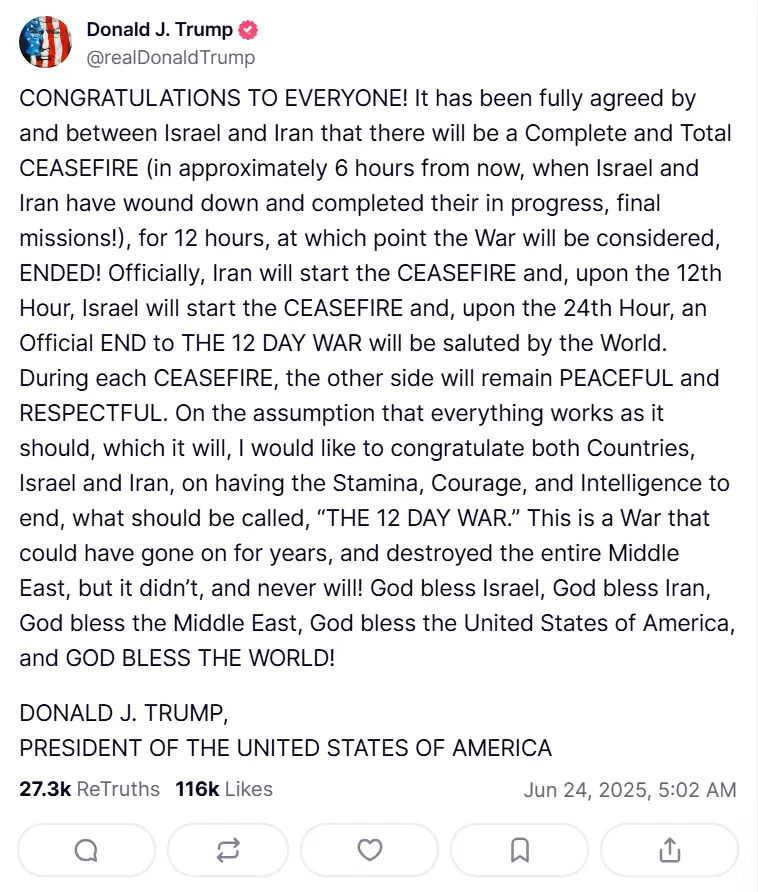On June 23, President Donald Trump announced that Israel and Iran have agreed to a “complete and total ceasefire”, effectively bringing an end to what he described as the “12‑day war.” This article explores the announcement, its phased implementation, and the ongoing uncertainty surrounding whether the truce will hold.
Trump’s Ceasefire Announcement
Late Monday, on his social media platform Truth Social, President Trump declared a ceasefire was set to begin in stages: “Iran will start the ceasefire immediately,” followed by Israel “after 12 hours,” and the conflict would officially be over 24 hours later. He referred to the agreement as “complete and total,” praising both nations for the stamina and courage to end hostilities.

Is There a Ceasefire Between Iran and Israel?
Despite Trump’s announcement, both Tehran and Jerusalem made no immediate public confirmations. Iran’s foreign minister, Abbas Araqchi, confirmed to Reuters that Iran would halt its missile strikes if Israel ceased its “illegal aggression” by Tuesday morning, though he warned the final decision rested on Israel’s actions. Similarly, Israeli officials reportedly agreed so long as Iran refrained from further attacks, but the Israel Defense Forces continued to intercept Iranian missiles in the early hours of Tuesday.
How Did Israel and Iran Agree to Ceasefire?
Trump credited Qatar, specifically its prime minister Sheikh Mohammed bin Abdulrahman Al Thani, for playing a key mediating role. He held calls with both Prime Minister Benjamin Netanyahu of Israel and Iranian officials, supported by U.S. envoys including Vice President JD Vance, Secretary of State Marco Rubio, and special envoy Steve Witkoff.
Details of the Ceasefire Agreement
President Trump’s announcement outlined a phased ceasefire:abcnews.go.com
-
Iran’s Initiation: Iran will commence a 12-hour ceasefire at midnight Eastern Time.
-
Israel’s Response: Following Iran’s 12-hour period, Israel will begin its own 12-hour ceasefire.
-
Official End: After 24 hours, the war will be officially declared over.
The ceasefire is contingent upon both nations halting military operations. Iran’s Foreign Minister Abbas Araghchi stated that Iran would cease attacks if Israel stopped its “illegal aggression.”
Persistent Uncertainty and Continued Hostilities
Despite the announcement, Iran reportedly launched missiles at Israel early Tuesday, and Israel maintained defense alerts. The Israel Defense Forces continued interceptions, and both nations issued evacuation warnings.
True validation of the ceasefire hinges on whether both Iran and Israel fully commit and halt their respective attacks as pledged. Riyals remain unclear without third-party or official confirmation.
Strategic and Market Impacts
Trump framed the truce as a testament to U.S. military and diplomatic strategy. U.S. airstrikes on Iranian nuclear sites—including Fordow, Natanz, and Esfahan—were pivotal in clearing the path to ceasefire, he said. While the U.S. seeks to pivot toward peace, some Middle Eastern nations and global observers expressed cautious hope but warned that tensions—especially in hotspots like the Strait of Hormuz—could flare again .
Will This Israel-Iran Ceasefire Last?
For now, what matters is this: Is there a ceasefire between Iran and Israel? President Trump insists the answer yes, with phased steps and diplomatic breakthroughs lending credibility. However, the repeated missile launches and military alerts post-announcement indicate that hostilities may not yet be fully contained.
As regions wait for a confirmed pause in fighting, stakeholders—especially in global markets and energy sectors—watch closely. The risk premium in oil prices has receded, but only sustained silence from both belligerents can offer genuine confirmation of peace.
Until both nations unequivocally cease fire, the truce remains tentative—but markets have already responded as if peace were real.


